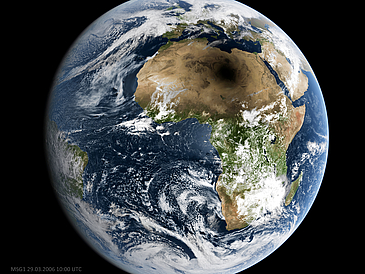It could be an eclipse of the sun, hurricanes, sunrise over Europe, or Sahara sand blowing across the Atlantic: A technique developed by Dr.Maximilian Reuter from the Institute of Environmental Physics at the University of Bremen captures such images – and reveals unusual views of our planet Earth. His outstanding technical publication on the topic has just earned him this year’s Len Curtis Prize awarded by the “Remote Sensing and Photogrammetry Society”. This is the first time the award has gone to a German scientist.
Images enabling an extraordinary perspective on the Earth
In his publication entitled “Moments from Space captured by MSGSEVIRI” the 39-year-old scientist describes a new remote-sensing technique for exploring the Earth. His innovation makes it possible to produce so-called real-color images of the Earth. These are raster graphics in which every single pixel contains three color values. “Due to their color resolution they appear just as realistic as photographs”, Reuter explains. The images are derived from data computed by measuring instruments called SEVIRI on board the European weather satellite MSG (EUMETSAT). With the aid of his new technique, Reuter is able to create a satellite picture of the Earth at any moment in time. The pictures have been given the name "Moments from Space" because every single one of them captures just a fleeting instant on Earth from an unusual perspective.
“These extraordinary images of the Earth viewed from the perspectives of the geosynchronous satellite were until now a privilege reserved only for NASA astronauts on the Apollo moon missions”, says Reuter. One of the images produced by means of the new technique is of the total eclipse of the sun on 29th March 2006. It was voted second-best picture of the year 2011 by “NASA's Earth Science Picture of the Day” (http://epod.usra.edu/blog/2011/08/total-solar-eclipse-from-the-perspective-of-space.html).
About Dr.Reuter:
Maximilian Reuter studied physics at the FU Berlin. Following his doctorate he worked at the Institute of Space Science at the FU Berlin, and afterwards in Offenbach for the German Meteorological Service in the department “Satellite Application Facility on Climate Monitoring”. In 2007 he took up his present position as a member of the research team at the University of Bremen‘s Institute of Environmental Physics, where he specialized on the remote-sensing of carbon dioxide from satellites, radiation transport, and clouds.
For further information, please contact:
Universität Bremen
Fachbereich Physik /Elektrotechnik
Institut für Umweltphysik
Dr.Maximilian Reuter
Phone: +49 421 218-62085
e-mail: maximilian.reuterprotect me ?!iup.physik.uni-bremenprotect me ?!.de
www.moments-from-space.com


